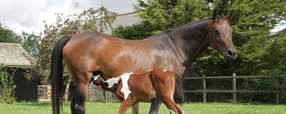The Lactating Mare
Once the mare has foaled and is lactating, her energy requirements will increase by as much as 44% and nutrients, such as protein, calcium, phosphorous and vitamin A, will be in particularly high demand. With the foal growing most rapidly during the first three months, the mare will give up to 3% of her bodyweight daily in milk production so, for example, a mare of 454kg will produce in the region of 13.6kgs of milk per day.
If the mare’s diet is deficient in calories at this stage, she will lose weight and, if deficient in quality protein, she will lose muscle and top line and “milk off her back”, whilst an inadequate supply of major and trace minerals means her liver and bone stores will be sacrificed.
The composition of mare’s milk changes rapidly during the first days of lactation with further gradual changes thereafter. The Mare Lactation Curve shows that the mare reaches peak milk volumes around five weeks into lactation, although exact volumes will depend on the number of previous lactations the mare has undertaken as well as her diet and the amount consumed by the foal per day. The graph of Mare’s Milk Mineral Density shows how the levels of key minerals decrease during lactation, with levels of these and other nutrients being influenced by the mare’s genetics plus her nutrient intake and requirements.
Feeding Advice
- Whilst good quality grass will make a significant contribution to the mare’s requirements, no modern pasture will provide all the vitamins and minerals she needs so some form of supplementation is essential.
- Good pasture management will maximise grass quality and quantity whilst pasture analysis will assist in determining necessary supplementation.

Ultimately, the quantity and quality of the mare’s milk will determine the foal’s growth rate, bodyweight and condition, particularly during the first three months of the foal’s life when it is totally dependent on the mother’s milk. If the mare has not received a balanced and energy dense ration, her milk is likely to be of a poor quality or she may not produce enough milk to support the foal’s growth.



